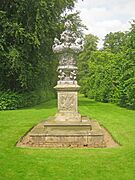Melbourne Hall facts for kids
Quick facts for kids Melbourne Hall |
|
|---|---|

Melbourne Hall - the garden front
|
|
| General information | |
| Town or city | Melbourne, Derbyshire |
| Country | England |
| Coordinates | 52°49′13″N 1°25′27″W / 52.8202°N 1.42420°W |
| Construction started | 17th century (with earlier origins) |
| Client | Sir John Coke |
| Design and construction | |
| Engineer | Richard Shepherd |
| Designations | House Grade II* listed Aisled barn Grade I listed Laundry Grade I listed |
Melbourne Hall is a beautiful country house located in Melbourne, Derbyshire, England. It's built in the Georgian style, which was popular in the 1700s and early 1800s. This historic house was once owned by the 2nd Viscount Melbourne, who was a very important person: he served as the British Prime Minister from 1835 to 1841.
Today, Melbourne Hall belongs to the 14th Marquess of Lothian. It is open to the public, so people can visit and explore its rich history and stunning gardens. The house itself is a special building, listed as Grade II*, meaning it's very important. Even more amazing, over twenty features in its gardens are listed as Grade I, which is the highest level of protection for historic buildings and sites in England!
Contents
History of Melbourne Hall
Melbourne was originally a manor, a large estate, that belonged to the Bishop of Carlisle way back in the 1100s. The house we see today began to take shape in the 1600s.
Building the Hall and Gardens
In 1629, Sir John Coke started rebuilding parts of the house. A local builder named Richard Shepherd helped with this work. Later, in 1692, the hall was inherited by Thomas Coke. He was a gentleman who loved architecture and design.
Thomas Coke was responsible for creating the amazing formal gardens that you can still see today. He worked with a professional gardener named Henry Wise between 1696 and 1706. They designed beautiful avenues, flowerbeds (called parterres), and a famous yew walk that has grown into a cool yew tunnel. The gardens also feature ponds, fountains, and many lead and stone sculptures.
Many of these sculptures were made by John Nost, a famous sculptor from the Netherlands who had a workshop in London. He created lead figures of little angels (amorini), vases, baskets of flowers, and figures from old myths. One of his most famous works at Melbourne Hall is the "Vase of the Seasons" from 1705. It's considered one of the best examples of Baroque lead sculpture in an English garden.
Changes Over Time
Thomas Coke also planned to update the house itself. While he had the west side rebuilt, it was his son, George Lewis Coke, who made bigger changes. In 1743–44, George Lewis rebuilt the east side of the house, which faces the garden, and adjusted the south side.
Throughout the 1700s, the inside of the house was redecorated several times. Important architects and artists worked on it. For example, in 1772, Joseph Pickford, a leading architect from Derbyshire, made more changes for the 1st Viscount Melbourne.
The house later passed to the Cowper family. This happened when Emily Lamb, who was the sister of the last Viscount Melbourne, married the 5th Earl Cowper. Emily Lamb later married another Prime Minister, Lord Palmerston.
The Cowper family owned Melbourne Hall until 1906. That's when Lady Amabel Cowper married Admiral of the Fleet Lord Walter Kerr. He made Melbourne Hall the main family home.
Current Ownership
Today, the owner of Melbourne Hall is the 14th Marquess of Lothian. He was previously known as Lord Ralph Kerr. He also owns another historic castle, Ferniehirst Castle, in Scotland.
Architecture and Gardens
Melbourne Hall is not just a house; its gardens are also a major part of its historical importance.
The House Structure
The main house has been well-maintained over the centuries. For example, its roof was completely replaced in 2012 to keep it in good condition.
The Famous Gardens
The gardens at Melbourne Hall are truly special. They feature beautiful wrought iron work created by Robert Bakewell. One of his most famous pieces is an arbour, a shaded seating area, known as the "birdcage."
This "birdcage" was carefully restored in 1958 by architect Louis Osman and ironwork experts. They studied Bakewell's original plans, removed a lot of old paint, and replaced many parts to bring it back to its original beauty and colors.
Protected Features
Melbourne Hall is a Grade II* listed building, which means it's recognized as a very important historic place. The gardens are especially notable because they have so many listed structures and statues, many of them at the highest Grade I level.
Some of the Grade I listed features include:
- Six pairs of cherubim (angel-like figures).
- Statues of Perseus, Mercury, and Andromeda from Greek myths.
- The famous Birdcage Arbour.
- The Muniment Room (a place for important documents) and a barn.
- Special seats near the Fountain Pond.
- Eight decorative vases.
- Two fountains on the Lower Terrace.
- The steps connecting the different garden terraces.
- The Tea Rooms.
- A pair of statues depicting slaves.
- The walls to the south and east of the house.
Other important features, listed at Grade II*, include walls on the top terrace, the water channel running through the garden and its bridges, the stables, and a grotto (a small cave-like structure). There's also an ice house, an urn, and metal flower baskets listed at Grade II.
Gallery





